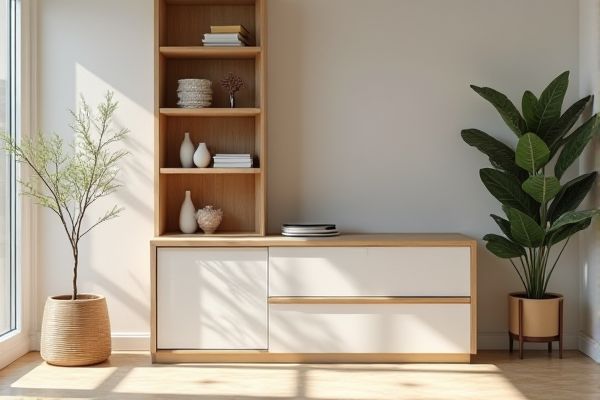
Open shelves provide easy access and display opportunities for your belongings, enhancing room aesthetics and ventilation, while closed cabinets offer more protection from dust, clutter concealment, and added security. Discover how to choose the best option for your space and lifestyle in the rest of this article.
Table of Comparison
| Feature | Open Shelf | Closed Cabinet |
|---|---|---|
| Accessibility | Easy and quick access | Requires opening doors |
| Visibility | Items are visible | Items hidden from view |
| Storage Protection | No protection from dust or damage | Protects from dust, moisture, and damage |
| Design & Style | Modern, minimal, display-friendly | Classic, neat, clutter-free appearance |
| Space Usage | Utilizes vertical space openly | Enclosed, helps conceal clutter |
| Maintenance | Requires frequent dusting | Lower maintenance, items stay cleaner |
| Best Use | Display items, easy reach essentials | Store valuables, hidden storage |
Introduction to Open Shelf and Closed Cabinet Storage
Open shelves offer easy access and visibility, making them ideal for frequently used items and decorative displays. Closed cabinets provide concealed storage, protecting belongings from dust and creating a streamlined look in your space. Choosing between open shelf and closed cabinet storage depends on your organizational needs and aesthetic preferences.
Key Differences Between Open Shelves and Closed Cabinets
Open shelves provide immediate visibility and easy access to items, making them ideal for frequently used kitchenware or decorative displays. Closed cabinets offer concealed storage that protects contents from dust and provides a cleaner, more organized appearance. The choice between open shelves and closed cabinets influences kitchen aesthetics, functionality, and maintenance requirements.
Aesthetic Appeal: Visual Impact in Home Design
Open shelves create a sense of spaciousness and showcase your curated items, enhancing the visual appeal by adding texture and color to your home design. Closed cabinets offer a sleek, uniform look that conceals clutter and provides a clean, minimalist aesthetic. Choosing between open shelves and closed cabinets depends on whether you prioritize display and openness or streamlined organization and subtlety in your space.
Space Optimization: Maximizing Storage Efficiency
Open shelves provide easy access and visual organization, making them ideal for frequently used items and maximizing vertical space without bulky doors. Closed cabinets protect contents from dust and clutter, allowing for concealed storage that helps maintain a clean, streamlined appearance while optimizing hidden storage capacity. Combining both options strategically enhances overall space optimization by balancing accessibility and neatness in any room.
Accessibility and Convenience for Everyday Use
Open shelves offer immediate accessibility, allowing you to quickly grab frequently used items without opening doors, making them ideal for everyday convenience. Closed cabinets protect belongings from dust and provide a cleaner, more organized appearance but require extra effort to open and close, which may slow down your routine. Choosing between the two depends on your need for easy access versus the desire for a tidy visual aesthetic in your space.
Maintenance and Cleaning Considerations
Open shelves require frequent dusting and cleaning since items are exposed to air and debris, making maintenance more intensive compared to closed cabinets. Closed cabinets protect contents from dust, dirt, and spills, reducing the frequency of cleaning for both the stored items and the cabinet interior. Choosing closed cabinets can prolong the lifespan of stored items by minimizing exposure to environmental contaminants.
Organization and Decluttering Strategies
Open shelves promote easy access and visibility, encouraging frequent decluttering and organization by displaying items neatly. Closed cabinets offer concealed storage, reducing visual clutter and protecting belongings from dust, ideal for maintaining a minimalist aesthetic. Combining both allows strategic organization, using open shelves for frequently used or decorative items and closed cabinets for less attractive or seldom-used storage.
Cost Comparison: Budgeting for Your Storage Solution
Open shelves generally cost less than closed cabinets due to simpler materials and construction, making them a budget-friendly storage option. Closed cabinets typically require more expensive hardware, doors, and finishes, increasing overall expenses for your project. Evaluating both options based on your storage needs and budget helps ensure you get the best value for your space.
Suitability for Different Rooms and Styles
Open shelves enhance living rooms and kitchens with a modern, airy aesthetic, perfect for displaying decorative items and frequently used kitchenware. Closed cabinets suit bedrooms, bathrooms, and home offices by offering concealed storage, maintaining a tidy, minimalist appearance while protecting belongings from dust. Contemporary and Scandinavian interiors often favor open shelving for openness, while traditional and rustic designs prefer closed cabinets for warmth and structure.
Choosing the Right Option: Factors to Consider
When choosing between open shelves and closed cabinets, consider factors such as accessibility, maintenance, and aesthetic preferences. Open shelves offer easy access and display opportunities but require regular cleaning and organization, while closed cabinets protect items from dust and provide a neater appearance. Evaluate your storage needs, kitchen size, and design style to select the option that best balances functionality and visual appeal.
 homyna.com
homyna.com